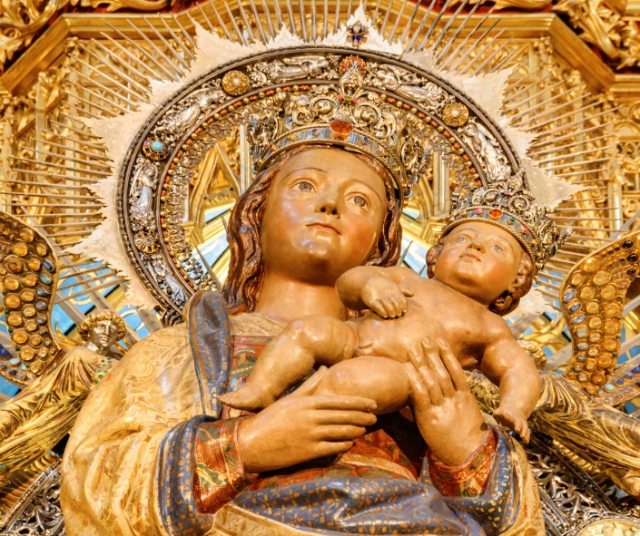The Day of the Almudena is a festivity of great importance in Spain, specifically in the city of Madrid. Every November 9, Madrid residents and visitors gather to honor their patron saint, the Virgin Mary under the patronage of La Almudena.
Origin and Meaning
Almudena Day is a celebration deeply rooted in the history and identity of Madrid, as well as in the Spanish Catholic tradition. Its origin dates back to medieval times and is linked to the Marian devotion of the Virgen de la Almudena , who became the patron saint of the city. The term "Almudena" derives from the Arabic word " al-mudayna ", which means "citadel". The Almudena's Marian dedication has a special connection with the city of Madrid, and its history is wrapped in a mixture of legend and religious tradition.
According to legend, during the Muslim invasion in the 8th century, the image of the Virgin Mary was hidden in the walls of Madrid to protect it from desecration. Centuries later, in the 11th century, when the Christians reconquered the city, the image of the Virgin was rediscovered in a chapel near the walls. This event marked the beginning of the devotion to the Virgen de la Almudena as protector and patron saint of Madrid. The official proclamation of the Virgen de la Almudena as patron saint of the city occurred on November 9, 1646. On this date, her role as intercessor and guardian of Madrid was recognized. Since then, November 9 has become an emblematic date in the religious and cultural calendar of the city.
The meaning of Almudena Day goes beyond a mere religious celebration. It represents the deep connection between the history of Madrid and its Catholic faith, as well as the desire for protection and guidance attributed to the Virgen de la Almudena. The festivity is an opportunity for the people of Madrid to express their devotion and gratitude to their patron saint, and for the new generations to learn about and participate in a tradition that has endured over the centuries.
The Religious Celebration
The Almudena Day festivity in Madrid acquires its full meaning through the religious celebration that takes place in the majestic Cathedral of Santa María la Real de la Almudena. This cathedral, located in the center of Madrid, is a monument of historical and spiritual importance, and its role in the celebration reflects the deep devotion that Madrileños feel towards their patron saint.
The day begins with a solemn mass in the cathedral. This mass, presided over by ecclesiastical and civil authorities, brings together thousands of faithful and pilgrims who gather to express their love and devotion to the Virgen de la Almudena. The interior of the cathedral is filled with an air of solemnity and spirituality, as attendees join in prayer and worship.
The image of the Virgen de la Almudena, dressed in rich clothing and with her characteristic crown, presides over the altar. The faithful go towards her with bouquets of flowers in their hands, as offerings of love and veneration. These flowers, carefully selected and arranged, fill the cathedral with color and fragrance that evoke the beauty and purity of the Virgin Mary.
The highlight of the mass is the offertory of flowers. One by one, the faithful approach the altar and place their flowers, creating a mosaic of colors and aromas at the feet of the Virgin. This tradition is a palpable manifestation of the Marian devotion that defines the Day of the Almudena. Each flower represents an act of love, a request or a thank you, and becomes a symbol of the connection between the earthly and the divine.
Sacred music and liturgical songs accompany the mass, raising the experience to an even higher level of emotion and spirituality. Choirs and musicians play an essential role in creating an atmosphere of reverence and solemnity that envelops those present in an atmosphere of worship.
The Procession of the Virgin
After the mass, an impressive procession takes place through the streets of Madrid. The image of the Virgen de la Almudena is carried on a litter through the streets of the city, accompanied by a multitude of faithful who sing hymns and pray. The procession is an expression of faith and community, as people of all ages and backgrounds come together to honor their patron saint.
The procession culminates in the Plaza Mayor, where the image is received with joy and applause. Here, a special blessing is celebrated and a massive floral offering is made in homage to the Virgin. The Plaza Mayor is filled with color and fervor, becoming a meeting and devotional place for Madrid residents and visitors.
Traditions and Popular Celebrations
In addition to the religious aspects, Almudena Day is also an opportunity to enjoy Spanish culture and gastronomy. On this day, it is common for families to get together to enjoy special foods and typical sweets. Among the most popular dishes are the traditional stews and desserts such as saint's bones and donuts. It is also common for the streets to be filled with fairs and festive activities. Madrid residents and visitors can find food, crafts and entertainment stalls in different parts of the city. These popular celebrations add a festive and joyous atmosphere to the occasion, making the Día de la Almudena a complete experience that combines the religious and the cultural.
Beyond the festivities and traditions, the Almudena Day is also a time for spiritual reflection. Devotion to the Virgin Mary and her role in the Catholic faith are central aspects of this celebration. The faithful take advantage of this opportunity to deepen their connection with the Virgin and to renew their commitment to the faith and Christian values.
